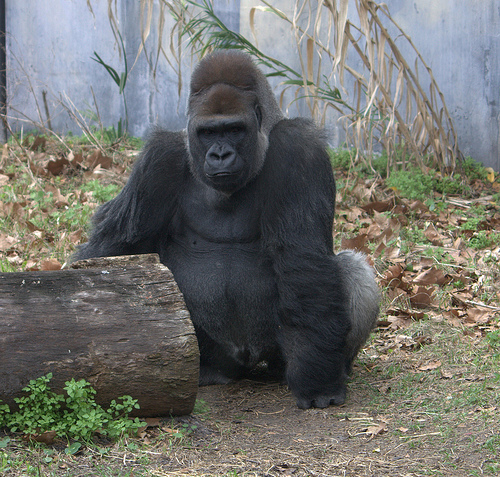Western gorillas are endangered giants.
- Western gorillas consist of two primate subspecies and are found in the tropical woodlands of western to central parts of Africa.
- Western gorillas have the scientific name Gorilla gorilla and are from the family Hominidae, the family of great apes.
- Western gorillas typically have black or grey coloured hair, and the upper head is generally brown.
- Western gorillas can grow to be 1.4 to 1.7 metres (4.7 to 5.5 feet) in length and generally weigh between 80 to 200 kilograms (220 to 440 pounds).
- Western gorillas move at speeds of 40 kilometres per hour (25 miles per hour) and they show capabilities of tool using.
Western Gorilla
Image courtesy of LaggedOnUser/Flickr
- Western gorillas have a slow rate of reproduction, usually only having a single offspring per birth; the mother cares for the young for three to four years; and fatalities are common in the early years.
- The diet of western gorillas primarily consists of vegetation including leaves, bark, fruit and nuts, as sometimes insects, rodents and lizards are consumed, and they are sometimes preyed on by leopards and crocodiles.
- Western gorillas usually reside in troops of two to twenty gorillas, and have a lifespan of approximately 35 to 40 years in the wild, and up to 54 years in captivity.
- Western gorillas are critically endangered due to poaching, habitat removal and viruses, and the population of the western lowland gorilla subspecies is said to be less than 200,000 and the Cross River gorilla subspecies is believed to have 300 or less.
- Western gorillas use vegetation to make nests on the ground or in trees, that they sleep in, and they usually build a new nest each day.
Bibliography:
Csomos R, Gorilla gorilla, 2008, Animal Diversity Web, http://animaldiversity.ummz.umich.edu/accounts/Gorilla_gorilla/
Western Gorilla, 2013, A-Z Animals, http://a-z-animals.com/animals/western-gorilla/
Western Gorilla, 2014, Wikipedia, http://en.wikipedia.org/wiki/Western_gorilla







